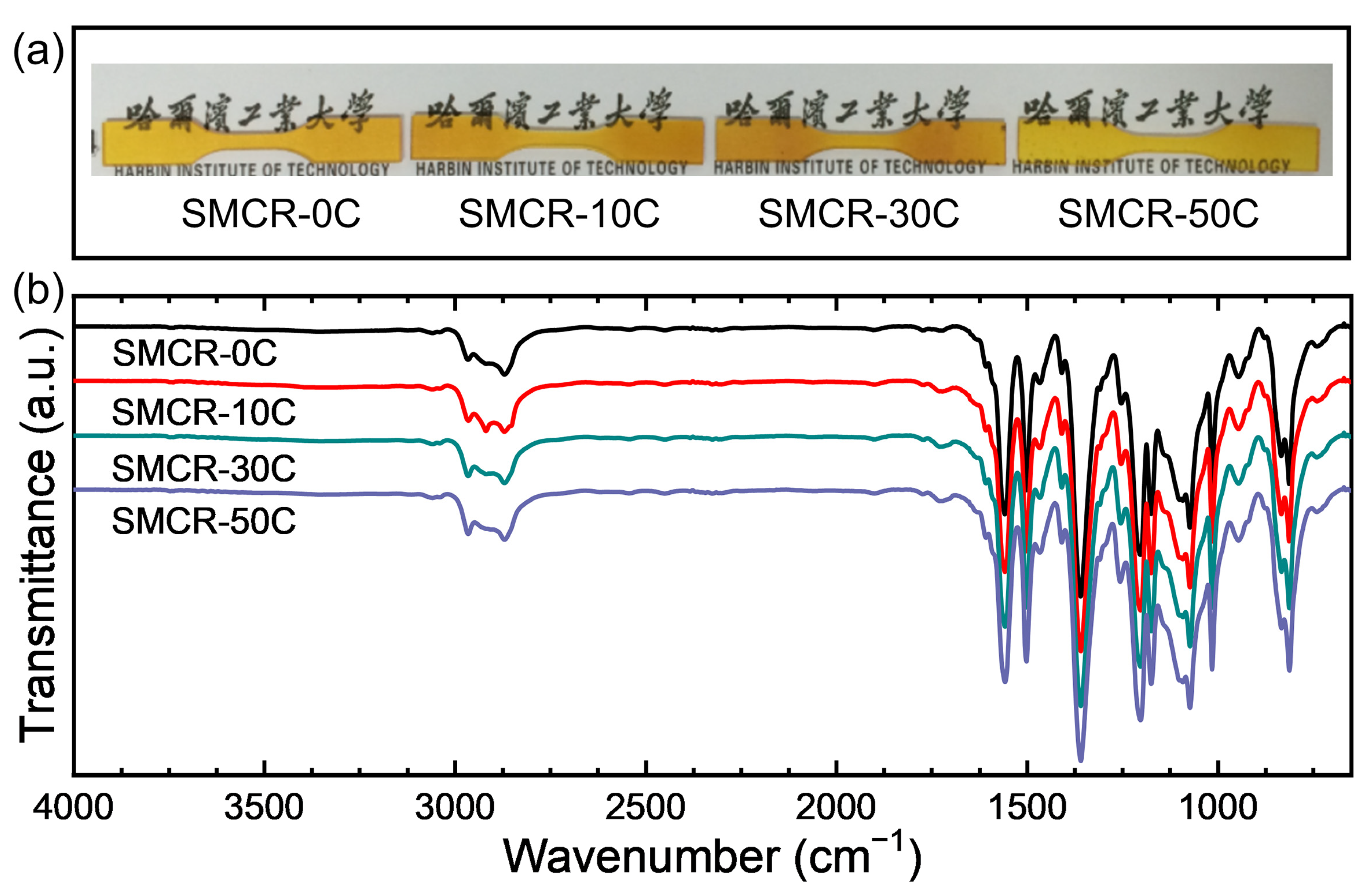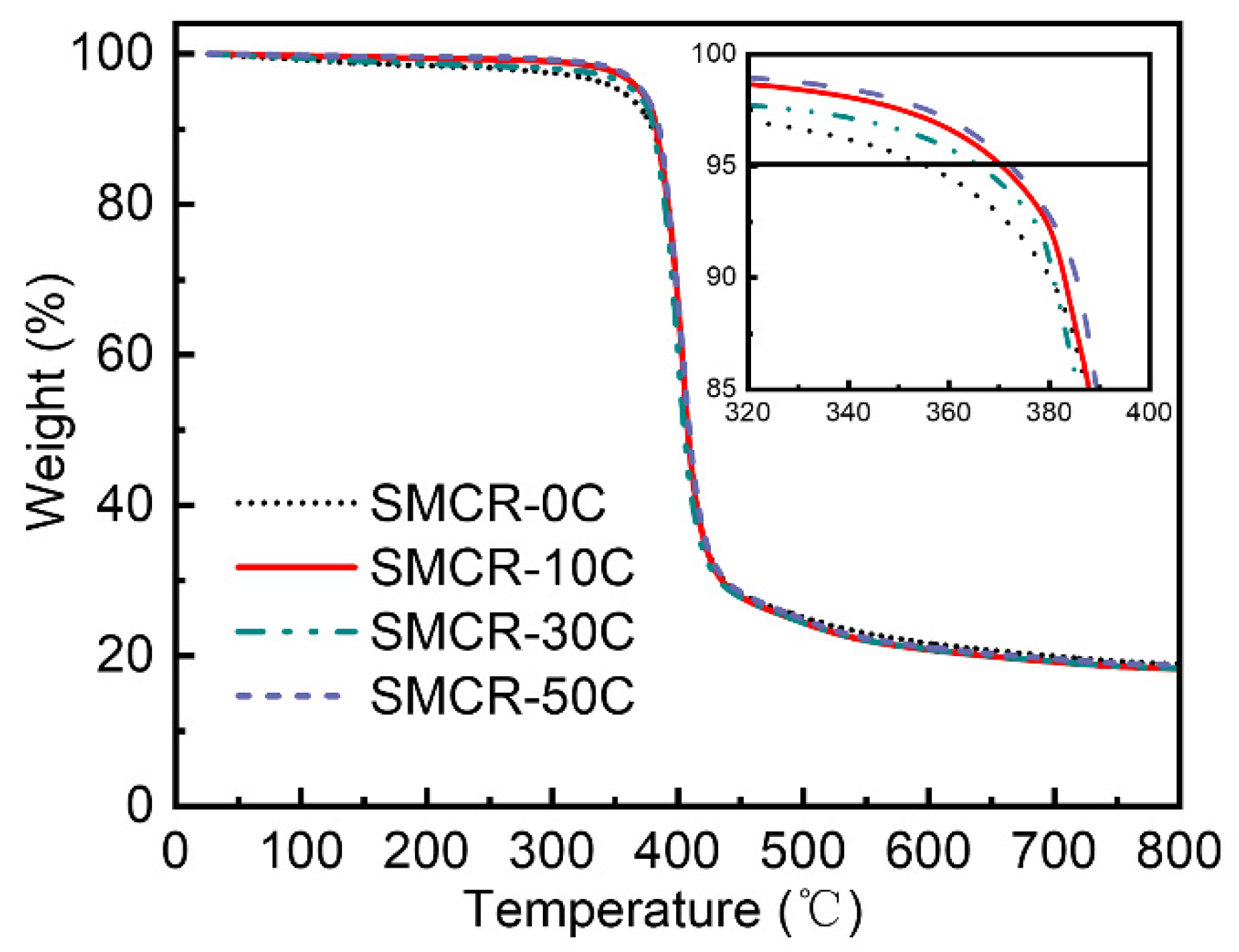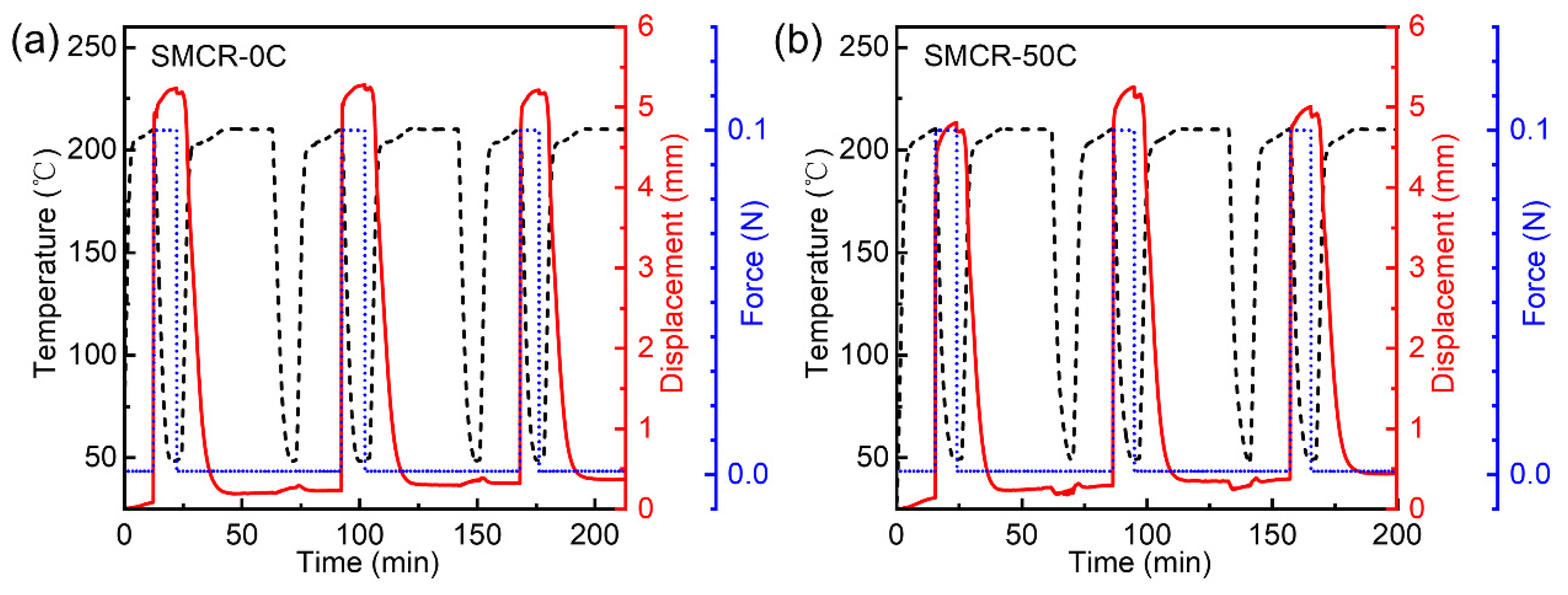Effects of Accelerated Aging on Thermal, Mechanical and Shape Memory Properties of Cyanate-Based Shape Memory Polymer: III Vacuum Thermal Cycling
Abstract
1. Introduction
2. Experiment
2.1. Materials and Methods
2.2. Vacuum Thermal Cycling Test
2.3. Characterization Method
3. Results and Discussion
3.1. Effects of Vacuum Thermal Cycling on Morphology and Chemical Composition
3.2. Effects of Vacuum Thermal Cycling on Thermal Stability
3.3. Effects of Vacuum Thermal Cycling on Mechanical Properties
3.4. Effects of Vacuum Thermal Cycling on Glass Transition Temperature
3.5. Effects of Vacuum Thermal Cycling on Shape Memory Effect
4. Conclusions
Author Contributions
Funding
Institutional Review Board Statement
Data Availability Statement
Conflicts of Interest
References
- Wang, X.; He, Y.; Liu, Y.; Leng, J. Advances in Shape Memory Polymers: Remote Actuation, Multi-stimuli Control, 4D Printing and Prospective Applications. Mater. Sci. Eng. R 2022, 151, 100702. [Google Scholar] [CrossRef]
- Xia, Y.; He, Y.; Zhang, F.; Liu, Y.; Leng, J. A Review of Shape Memory Polymers and Composites: Mechanisms, Materials, and Applications. Adv. Mater. 2021, 33, e2000713. [Google Scholar] [CrossRef] [PubMed]
- Deng, Y.; Yang, B.; Zhang, F.; Liu, Y.; Sun, J.; Zhang, S.; Zhao, Y.; Yuan, H.; Leng, J. 4D Printed Orbital Stent for the Treatment of Enophthalmic Invagination. Biomaterials 2022, 291, 121886. [Google Scholar] [CrossRef] [PubMed]
- Dong, C.; Yang, C.; Younis, M.R.; Zhang, J.; He, G.; Qiu, X.; Fu, L.H.; Zhang, D.Y.; Wang, H.; Hong, W.; et al. Bioactive NIR-II Light-Responsive Shape Memory Composite Based on Cuprorivaite Nanosheets for Endometrial Regeneration. Adv. Sci. 2022, 9, e2102220. [Google Scholar] [CrossRef]
- Cai, S.; Niu, B.; Ma, X.; Wan, S.; He, X. High Strength, Recyclable, Anti-Swelling and Shape-Memory Hydrogels based on Crystal Microphase Crosslinking and Their Application as Flexible Sensor. Chem. Eng. J. 2022, 430, 132957. [Google Scholar] [CrossRef]
- Wu, S.; Guo, J.; Wang, Y.; Xie, H.; Zhou, S. Cryopolymerized Polyampholyte Gel with Antidehydration, Self-Healing, and Shape-Memory Properties for Sustainable and Tunable Sensing Electronics. ACS Appl. Mater. Interfaces 2022, 14, 42317–42327. [Google Scholar] [CrossRef]
- Liang, Y.; Shen, Y.; Liang, H. Solvent-Responsive Strong Hydrogel with Programmable Deformation and Reversible Shape Memory for Load-Carrying Soft Robot. Mater. Today Commun. 2022, 30, 103067. [Google Scholar] [CrossRef]
- Xu, Z.; Wei, D.W.; Bao, R.Y.; Wang, Y.; Ke, K.; Yang, M.B.; Yang, W. Self-Sensing Actuators Based on a Stiffness Variable Reversible Shape Memory Polymer Enabled by a Phase Change Material. ACS Appl. Mater. Interfaces 2022, 14, 22521–22530. [Google Scholar] [CrossRef]
- Zhang, B.; Li, H.; Cheng, J.; Ye, H.; Sakhaei, A.H.; Yuan, C.; Rao, P.; Zhang, Y.F.; Chen, Z.; Wang, R.; et al. Mechanically Robust and UV-Curable Shape-Memory Polymers for Digital Light Processing Based 4D Printing. Adv. Mater. 2021, 33, e2101298. [Google Scholar] [CrossRef]
- Zhang, W.; Wang, H.; Wang, H.; Chan, J.Y.E.; Liu, H.; Zhang, B.; Zhang, Y.F.; Agarwal, K.; Yang, X.; Ranganath, A.S.; et al. Structural multi-colour invisible inks with submicron 4D printing of shape memory polymers. Nat. Commun. 2021, 12, 112. [Google Scholar] [CrossRef]
- Ping, Z.; Fang, H.; Wang, K.; Zhang, H.; Li, S.; Chen, J.; Huang, F. A Universal Cl-PEDOT Coating Strategy Based on Oxidative Chemical Vapor Deposition toward Solar-Driven Multifunctional Energy Management. Adv. Funct. Mater. 2022, 32, 2208965. [Google Scholar] [CrossRef]
- Zhao, L.; Wang, L.; Shi, J.; Hou, X.; Wang, Q.; Zhang, Y.; Wang, Y.; Bai, N.; Yang, J.; Zhang, J.; et al. Shape-Programmable Interfacial Solar Evaporator with Salt-Precipitation Monitoring Function. ACS Nano 2021, 15, 5752–5761. [Google Scholar] [CrossRef]
- Ma, X.; Li, T.; Ma, J.; Wang, Z.; Shi, C.; Zheng, S.; Cui, Q.; Li, X.; Liu, F.; Guo, H.; et al. Recent Advances in Space-Deployable Structures in China. Engineering 2022, 17, 207–219. [Google Scholar]
- Kuehme, D.; Alley, N.R.; Phillips, C.; Cogan, B.R. Flight Test Evaluation and System Identification of the Area-I Prototype-Technology-Evaluation Research Aircraft (PTERA). AIAA Flight Test. Conf. 2014, 2, 1–74. [Google Scholar]
- Xie, F.; Liu, L.; Gong, X.; Huang, L.; Leng, J.; Liu, Y. Effects of Accelerated Aging on Thermal, Mechanical and Shape Memory Properties of Cyanate-Based Shape Memory Polymer: I Vacuum Ultraviolet Radiation. Polym. Degrad. Stabil. 2017, 138, 91–97. [Google Scholar] [CrossRef]
- Lu, Y.; Shao, Q.; Yue, H.; Yang, F. A Review of the Space Environment Effects on Spacecraft in Different Orbits. IEEE Access 2019, 7, 93473–93488. [Google Scholar] [CrossRef]
- Aberoumand, M.; Soltanmohammadi, K.; Rahmatabadi, D.; Soleyman, E.; Ghasemi, I.; Baniassadi, M.; Abrinia, K.; Bodaghi, M.; Baghani, M. 4D Printing of Polyvinyl Chloride (PVC): A Detailed Analysis of Microstructure, Programming, and Shape Memory Performance. Macromol. Mater. Eng. 2023, 5, 2200677. [Google Scholar] [CrossRef]
- Soleyman, E.; Aberoumand, M.; Rahmatabadi, D.; Soltanmohammadi, K.; Ghasemi, I.; Baniassadi, M.; Abrinia, K.; Baghani, M. Assessment of Controllable Shape Transformation, Potential Applications, and Tensile Shape Memory Properties of 3D Printed PETG. J. Mater. Res. Technol. 2022, 18, 4201–4215. [Google Scholar] [CrossRef]
- Soleyman, E.; Aberoumand, M.; Soltanmohammadi, K.; Rahmatabadi, D.; Ghasemi, I.; Baniassadi, M.; Abrinia, K.; Baghani, M. 4D Printing of PETG via FDM Including Tailormade Excess Third Shape. Manuf. Lett. 2022, 33, 1–4. [Google Scholar] [CrossRef]
- Soleyman, E.; Rahmatabadi, D.; Soltanmohammadi, K.; Aberoumand, M.; Ghasemi, I.; Abrinia, K.; Baniassadi, M.; Wang, K.; Baghani, M. Shape Memory Performance of PETG 4D Printed Parts Under Compression in Cold, Warm, and Hot Programming. Smart Mater. Struct. 2022, 31, 085002. [Google Scholar] [CrossRef]
- Cao, G.; Lin, H.; Fraser, S.; Zheng, X.; Del Rosal, B.; Gan, Z.; Wei, S.; Gan, X.; Jia, B. Resilient Graphene Ultrathin Flat Lens in Aerospace, Chemical, and Biological Harsh Environments. ACS Appl. Mater. Interfaces 2019, 11, 20298–20303. [Google Scholar] [CrossRef]
- Liu, Y.; Du, H.; Liu, L.; Leng, J. Shape Memory Polymers and Their Composites in Aerospace Applications: A review. Smart Mater. Struct. 2014, 23, 023001. [Google Scholar] [CrossRef]
- Ye, S.; Cheng, C.; Chen, X.; Chen, X.; Shao, J.; Zhang, J.; Hu, H.; Tian, H.; Li, X.; Ma, L.; et al. High-Performance Piezoelectric Nanogenerator Based on Microstructured P(VDF-TrFE)/BNNTs Composite for Energy Harvesting and Radiation Protection in Space. Nano Energy 2019, 60, 701–714. [Google Scholar] [CrossRef]
- Sowan, N.; Song, H.B.; Cox, L.M.; Patton, J.R.; Fairbanks, B.D.; Ding, Y.; Bowman, C.N. Light-Activated Stress Relaxation, Toughness Improvement, and Photoinduced Reversal of Physical Aging in Glassy Polymer Networks. Adv. Mater. 2021, 33, e2007221. [Google Scholar] [CrossRef] [PubMed]
- Hou, L.; Wu, Y.; Xiao, J.; Guo, B.; Zong, Y. Degeneration and Damage Mechanism of Epoxy-based Shape Memory Polymer under 170 keV Vacuum Proton Irradiation. Polym. Degrad. Stabil. 2019, 166, 8–16. [Google Scholar] [CrossRef]
- Wang, L.; Zhang, F.; Liu, Y.; Leng, J. γ-Rays Radiation Resistant Shape Memory Cyanate Ester Resin and its Composites with High Transition Temperature. Smart Mater. Struct. 2019, 28, 075039. [Google Scholar] [CrossRef]
- Xie, F.; Huang, L.; Liu, Y.; Leng, J. Synthesis and Characterization of High Temperature Cyanate-based Shape Memory Polymers with Functional Polybutadiene/Acrylonitrile. Polymer 2014, 55, 5873–5879. [Google Scholar] [CrossRef]
- Lan, X.; Liu, L.; Zhang, F.; Liu, Z.; Wang, L.; Li, Q.; Peng, F.; Hao, S.; Dai, W.; Wan, X.; et al. World’s First Spaceflight on-orbit Demonstration of a Flexible Solar Array System based on Shape Memory Polymer Composites. Sci. China Technol. Sci. 2020, 63, 1436–1451. [Google Scholar] [CrossRef]
- Xie, F.; Gong, X.; Huang, L.; Liu, L.; Leng, J.; Liu, Y. Effects of Accelerated Aging on Thermal, Mechanical, and Shape Memory Properties of a Cyanate-based Shape Memory Polymer: II Atomic Oxygen. Polym. Degrad. Stabil. 2021, 186, 109515. [Google Scholar] [CrossRef]
- Chen, Y.; Tan, S.; Li, N.; Huang, B.; Niu, X.; Li, L.; Sun, M.; Zhang, Y.; Zhang, X.; Zhu, C.; et al. Self-Elimination of Intrinsic Defects Improves the Low-Temperature Performance of Perovskite Photovoltaics. Joule 2020, 4, 1961–1976. [Google Scholar] [CrossRef]
- Ganilova, O.A.; Cartmell, M.P.; Kiley, A. Application of a Dynamic Thermoelastic Coupled Model for an Aerospace Aluminium Composite Panel. Compos. Struct. 2022, 288, 115423. [Google Scholar] [CrossRef]
- Paul, B.; Bailly, L.; Bégué, D.; Lartigau-Dagron, C.; Hassoune-Rhabbour, B.; Nassiet, V. Thermal Degradation Mechanisms of the Cured Phenolic Triazine Thermoset Resin (PT30) Studied under Nitrogen. Polym. Degrad. Stabil. 2023, 208, 110250. [Google Scholar] [CrossRef]
- Tian, Y.; Kong, M.; Tao, Z.; Yang, C.; Shang, S.; Gu, Q.; Tsang, D.C.W.; Li, L.; Shang, J. Efficient Adsorption Removal of NO2 by Covalent Triazine Frameworks with Fine-Tuned Binding Sites. J. Hazard. Mater. 2023, 441, 129962. [Google Scholar] [CrossRef]
- Zhang, H.; Sun, W.; Chen, X.; Wang, Y. Few-Layered Fluorinated Triazine-Based Covalent Organic Nanosheets for High-Performance Alkali Organic Batteries. ACS Nano 2019, 13, 14252–14261. [Google Scholar] [CrossRef] [PubMed]
- Fyfe, C.A.; Niu, J.; Rettig, S.J.; Burlinson, N.E. High-Resolution 13C and 15N NMR Investigations of the Mechanism of the Curing Reactions of Cyanate-Based Polymer Resins in Solution and the Solid State. Macromolecules 1992, 25, 6289–6301. [Google Scholar] [CrossRef]
- Garrison, M.D.; Harvey, B.G. Structure-Property Relationships of Cis-Resveratrol Cyanate Ester Blends. Polymer 2021, 213, 123194. [Google Scholar] [CrossRef]
- Muldoon, J.A.; Garrison, M.D.; Savolainen, M.A.; Harvey, B.G. Ambient Temperature Cross-Linking of a Sustainable, Cardanol-Based Cyanate Ester via Synergistic Thiolene Copolymerization. Polym. Chem. 2022, 13, 3091–3101. [Google Scholar] [CrossRef]
- Tong, Y.; Dong, X.; Qi, M. Improved Tunable Range of the Field-Induced Storage Modulus by using Flower-Like Particles as the Active Phase of Magnetorheological Elastomers. Soft Matter 2018, 14, 3504–3509. [Google Scholar] [CrossRef]
- Xia, Y.; Larock, R.C. Castor Oil-Based Thermosets with Varied Crosslink Densities Prepared by Ring-Opening Metathesis Polymerization (ROMP). Polymer 2010, 51, 2508–2514. [Google Scholar] [CrossRef]
- Jang, J.H.; Hong, S.B.; Kim, J.G.; Goo, N.S.; Yu, W.R. Accelerated Testing Method for Predicting Long-Term Properties of Carbon Fiber-Reinforced Shape Memory Polymer Composites in a Low Earth Orbit Environment. Polymers 2021, 13, 1628. [Google Scholar] [CrossRef]
- Li, W.; Liu, Y.; Leng, J. Programmable and Shape-Memorizing Information Carriers. ACS Appl. Mater. Interfaces 2017, 9, 44792–44798. [Google Scholar] [CrossRef] [PubMed]
- Leng, J.; Lan, X.; Liu, Y.; Du, S. Shape-Memory Polymers and Their Composites: Stimulus Methods and Applications. Prog. Mater. Sci. 2011, 56, 1077–1135. [Google Scholar] [CrossRef]
- Xie, F.; Huang, C.; Wang, F.; Huang, L.; Weiss, R.A.; Leng, J.; Liu, Y. Carboxyl-Terminated Polybutadiene-Poly(styrene-co-4-vinylpyridine) Supramolecular Thermoplastic Elastomers and Their Shape Memory Behavior. Macromolecules 2016, 49, 7322–7330. [Google Scholar] [CrossRef]
- Xie, F.; Ping, Z.; Xu, W.; Zhang, F.; Dong, Y.; Li, L.; Zhang, C.; Gong, X. A Metal Coordination-Based Supramolecular Elastomer with Shape Memory-Assisted Self-Healing Effect. Polymers 2022, 14, 4879. [Google Scholar] [CrossRef] [PubMed]






| Input Parameter | Output Parameter | SMCR-0C | SMCR-50C | |
| Programming Temperature (°C) | ~210 | |||
| Loading Mode | DMA-force control-three-point bending mode | Average Shape Fixation Rate (%) | 97.6 | 97.8 |
| Deformation Rate | Midpoint displacement 5 mm | |||
| Heating Rate (°C/min) | ~7.36 | |||
| Load Holding Time (min) | ~10 | Average Shape Recovery Rate (%) | 97.6 | 97.7 |
| Cooling Rate (°C/min) | ~6 | |||
| Recovery Temperature (°C) | ~48.65 |
Disclaimer/Publisher’s Note: The statements, opinions and data contained in all publications are solely those of the individual author(s) and contributor(s) and not of MDPI and/or the editor(s). MDPI and/or the editor(s) disclaim responsibility for any injury to people or property resulting from any ideas, methods, instructions or products referred to in the content. |
© 2023 by the authors. Licensee MDPI, Basel, Switzerland. This article is an open access article distributed under the terms and conditions of the Creative Commons Attribution (CC BY) license (https://creativecommons.org/licenses/by/4.0/).
Share and Cite
Ping, Z.; Xie, F.; Gong, X.; Liu, L.; Leng, J.; Liu, Y. Effects of Accelerated Aging on Thermal, Mechanical and Shape Memory Properties of Cyanate-Based Shape Memory Polymer: III Vacuum Thermal Cycling. Polymers 2023, 15, 1893. https://doi.org/10.3390/polym15081893
Ping Z, Xie F, Gong X, Liu L, Leng J, Liu Y. Effects of Accelerated Aging on Thermal, Mechanical and Shape Memory Properties of Cyanate-Based Shape Memory Polymer: III Vacuum Thermal Cycling. Polymers. 2023; 15(8):1893. https://doi.org/10.3390/polym15081893
Chicago/Turabian StylePing, Zhongxin, Fang Xie, Xiaobo Gong, Liwu Liu, Jinsong Leng, and Yanju Liu. 2023. "Effects of Accelerated Aging on Thermal, Mechanical and Shape Memory Properties of Cyanate-Based Shape Memory Polymer: III Vacuum Thermal Cycling" Polymers 15, no. 8: 1893. https://doi.org/10.3390/polym15081893
APA StylePing, Z., Xie, F., Gong, X., Liu, L., Leng, J., & Liu, Y. (2023). Effects of Accelerated Aging on Thermal, Mechanical and Shape Memory Properties of Cyanate-Based Shape Memory Polymer: III Vacuum Thermal Cycling. Polymers, 15(8), 1893. https://doi.org/10.3390/polym15081893







